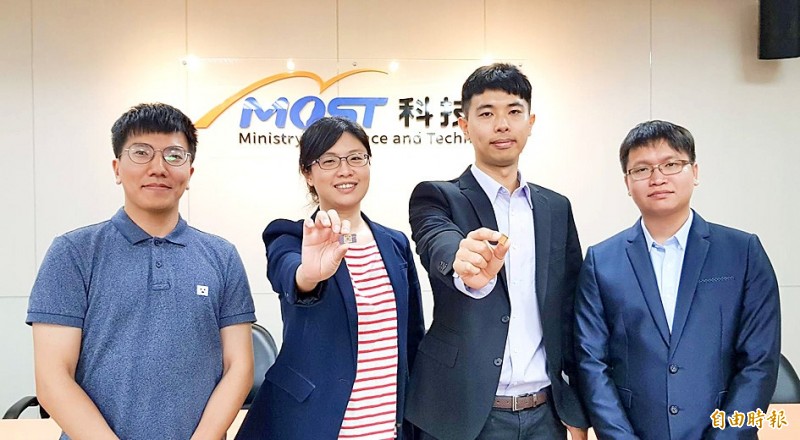《TAIPEI TIMES》 Breakthrough expected to aid quantum technology

National Cheng Kung University Department of Physics professor Chen Yi-chun and assistant professor Yang Jan-chi, second and third left, hold samples of their optically controlled bismuth ferrite memory material at the Ministry of Science and Technology in Taipei yesterday. Photo: Chien Hui-ju, Taipei Times
FIRST TIME EVER: A team of researchers controlled a bismuth ferrite memory unit using laser illumination, reducing delay in data access and energy consumption
By Lin Chia-nan / Staff reporter
A team led by National Cheng Kung University (NCKU) physicists yesterday announced a major breakthrough regarding a next-generation memory storage material that is expected to multiply the efficiency of memory units and pave the way for quantum technology development.
Traditional memory devices process information based on two logic states — zero and one — while their efficiency can be improved only by increasing the density of components and reducing their size, department of physics assistant professor Yang Jan-chi (楊展其) said.
To eliminate the bottleneck in memory development, the team turned to an alternative material — bismuth ferrite (BiFeO3), a material that can record eight logic states and keep the stored information for up to a year even when it is not powered or is heated up to 400°C, Yang said.
The main breakthrough involves controlling the material through laser illumination, which helps reduce delays in the reading of data and energy consumption, while boosting calculation efficiency, he said.
No other researchers have attempted to control high-density memory material using optical means, he said.
Yang, 32, is also enrolled in a Ministry of Science and Technology young talent cultivation program.
The development of BiFeO3 largely remains at the level of academic research and the team has found that the light-driven flexoelectric effect is key to its manipulation, professor Chen Yi-chun (陳宜君) said.
As light presents alternating electromagnetic fields, it is seldom used to control the operations of memory materials, she said.
Nonetheless, the team found that the material’s operations could be manipulated when placed on a surface whose strain gradient is slightly altered by illumination, she said.
The findings were detailed in a paper titled “Deterministic optical control of room temperature multiferroicity in BiFeO3 thin films,” published in the journal Nature Materials on May 6.
The team submitted the manuscript in July last year and it was accepted in March, Chen said.
The team expressed gratitude to collaborators at Hsinchu-based National Synchrotron Radiation Research Center and National Chiao Tung University, as well as members from Germany’s Max-Planck Institute for Chemical Physics of Solids, the University of Texas at Arlington and Lawrence Berkeley National Laboratory, and the University of New South Wales.
While more time is needed before the technology becomes commercially applicable, its discovery brings the nation a step closer to quantum computing technology, which would require highly efficient calculating units, NCKU vice president for research and development Hsieh Sun-yuan (謝孫源) said.
新聞來源:TAIPEI TIMES
%http://www.taipeitimes.com/
















